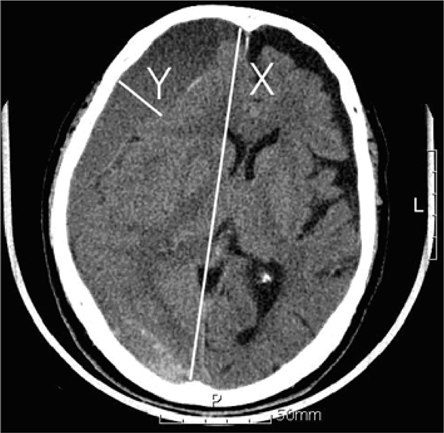J Korean Neurotraumatol Soc.
2010 Jun;6(1):33-37. 10.13004/jknts.2010.6.1.33.
Prediction of Postoperative Drainage Volume and Brain Expansion of Chronic Subdural Hematoma: Supplementary Study-Clinical Study
- Affiliations
-
- 1Department of Neurosurgery, College of Medicine, Inha University, Incheon, Korea. dkhyun@inha.ac.kr
- KMID: 2192359
- DOI: http://doi.org/10.13004/jknts.2010.6.1.33
Abstract
OBJECTIVE
The authors studied the factors associated with postoperative drainage volume after burr-hole craniostomy for chronic subdural hematoma (CSDH) to predict real postoperative drainage volume, and the relation between brain expansion and drained hematoma volume.
METHODS
During the last 7 years, 75 patients with CSDH had been undertaken burrhole drainage. For these, demographical and radiological data regarding CSDH were gathered and reviewed, including hematoma density, volume, and parameters of brain compliance on computed tomography (CT) scan. We estimated the brain expansion using the degree of frontal horn compression and midline shifting by the B/A ratios, and made statistical analyses for relation with the postoperative drainage volume.
RESULTS
In a whole, the estimated volume was 139 mL, mean real drainage volume was 261 mL, and mean B/A ratio was 0.53. There was no statistical significance between estimated and real drainage volumes. Among 4 groups, low density subgroup showed the largest difference between estimated volume (128 mL) and mean real drainage volume (214 mL), and lowest mean B/A ratio of 0.5. B/A ratio had inverse relationship with real drainage volume (p<0.05).
CONCLUSION
The postoperative drainage volume after operation of CSDH was affected by brain expansion. Postoperative drainage volume was decreased as the B/A ratio was increased, and vice versa. Postoperative drainage volume of CSDH, in some extent, can be predicted with the density types of CSDH and the degree of frontal horn compression.
Figure
Cited by 2 articles
-
Early Decompression of Acute Subdural Hematoma for Postoperative Neurological Improvement: A Single Center Retrospective Review of 10 Years
Chang Hyun Oh, Yu Shik Shim, Seung Hwan Yoon, Dongkeun Hyun, Hyeonseon Park, Eunyoung Kim
Korean J Neurotrauma. 2016;12(1):11-17. doi: 10.13004/kjnt.2016.12.1.11.Effects of Newly Designed Drainage Catheter in Treating Chronic Subdural Hematoma
Bum-Soo Park, Seung-Won Choi, Hyon-Jo Kwon, Seon-Hwan Kim, Hyeon-Song Koh, Jin-Young Youm, Shi-Hun Song
Korean J Neurotrauma. 2013;9(2):87-91. doi: 10.13004/kjnt.2013.9.2.87.
Reference
-
1. Choi WC, Kang JK, Jung HT, Doh JO. Clinical analysis of chronic subdural hematoma. J Korean Neurosurg Soc. 1993; 22:40–47.2. Chung YS, Kim HJ, Han DH. Surgical management of chronic subdural hematoma: the outcome and factors relating to the brain expansion. J Korean Neurosurg Soc. 1993; 22:1239–1249.3. Ernestus RI, Beldzinski P, Lanfermann H, Klug N. Chronic subdural hematoma: surgical treatment and outcome in 104 patients. Surg Neurol. 1997; 48:220–225.
Article4. Fukuhara T, Gotoh M, Asari S, Ohmoto T, Akioka T. The relationship between brain surface elastance and brain reexpansion after evacuation of chronic subdural hematoma. Surg Neurol. 1996; 45:570–574.
Article5. Kasner SE. Geometry and subdural hematoma volume. Stroke. 1999; 30:188.
Article6. Kwon TH, Park YK, Lim DJ, Cho TH, Chung YG, Chung HS, et al. Chronic subdural hematoma: evaluation of the clinical significance of postoperative drainage volume. J Neurosurg. 2000; 93:796–799.
Article7. Lee SC, Kang JK, Jung HT, Dho JO. Factors affecting brain reexpansion after simple burr hole drainage in chronic subdural hematoma. J Korean Neurosurg Soc. 1998; 27:757–762.8. Markwalder TM. Chronic subdural hematomas: a review. J Neurosurg. 1981; 54:637–645.
Article9. Matsumoto K, Akagi K, Abekurua M, Ryujin H, Ohkawa M, Iwasa N, et al. Recurrence factors for chronic subdural hematomas after burr-hole craniostomy and closed system drainage. Neurol Res. 1999; 21:277–280.
Article10. Mori K, Maeda M. Surgical treatment of chronic subdural hematoma in 500 consecutive cases: clinical characteristics, surgical outcome, complications, and recurrence rate. Neurol Med Chir (Tokyo). 2001; 41:371–381.
Article11. Nomura S, Kashiwagi S, Fujisawa H, Ito H, Nakamura K. Characterization of local hyperfibrinolysis in chronic subdural hematomas by SDS-PAGE and immunoblot. J Neurosurg. 1994; 81:910–913.
Article12. Obana WG, Pitts LH. Management of head injury. Extracerebral lesions. Neurosurg Clin N Am. 1991; 2:351–372.13. Petersen OF, Espersen JO. Extradural hematomas: measurement of size by volume summation on CT scanning. Neuroradiology. 1984; 26:363–367.
Article14. Schachenmayr W, Friede RL. The origin of subdural neomembranes. I. Fine structure of the dura-arachnoid interface in man. Am J Pathol. 1978; 92:53–68.15. Sucu HK, Gökmen M, Ergin A, Bezircioğlu H, Gökmen A. Is there a way to avoid surgical complications of twist drill craniostomy for evacuation of a chronic subdural hematoma? Acta Neurochir (Wien). 2007; 149:597–599.
Article16. Sucu HK, Gokmen M, Gelal F. The value of XYZ/2 technique compared with computer-assisted volumetric analysis to estimate the volume of chronic subdural hematoma. Stroke. 2005; 36:998–1000.
Article17. Tabaddor K, Shulmon K. Definitive treatment of chronic subdural hematoma by twist-drill craniostomy and closed-system drainage. J Neurosurg. 1977; 46:220–226.
Article18. Tsutsumi K, Maeda K, Iijima A, Usui M, Okada Y, Kirino T. The relationship of preoperative magnetic resonance imaging findings and closed system drainage in the recurrence of chronic subdural hematoma. J Neurosurg. 1997; 87:870–875.
Article
- Full Text Links
- Actions
-
Cited
- CITED
-
- Close
- Share
- Similar articles
-
- Relationship of Fibrinogen Degradation Products to Clinical Findings in Chronic Subdural Hematoma
- Controlled Ventricular Infusion in Treatment of Chronic Subdural Hematoma
- The Relationship between Postoperative Drainage Volume and Brain Shifting Index in Chronic Subdural Hematoma
- Factors Affecting Brain Re-expansion after Simple Burr Hole Drainage in Chronic Subdural Hematoma
- Surgical Management of Chronic Subdural Hematoma:The Outcome and Factors Relating to The Brain Expansion





